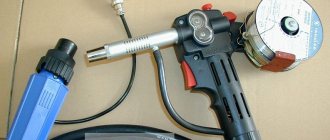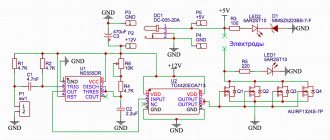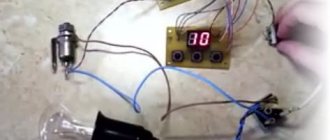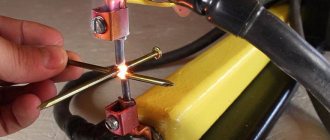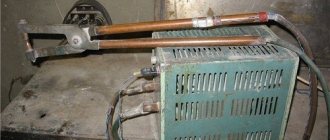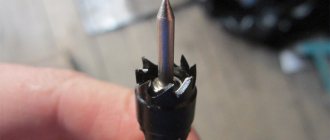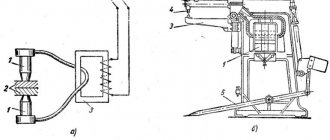Homemade contact welding pliers - device and principle of operation! The most common method of joining and cutting metals is welding. There are different options for welding work, which depend directly on the materials and equipment used. To work with small products, a contact connection method was developed, the essence of which is to heat the metal using an electric current. Current is passed through the metal in a specific welding zone, connecting the products to each other. Preliminary preparation of the surfaces to be joined, the strength of the electric current, the duration of exposure of the current to the place where the metal is joined, as well as the compression force of the parts being welded are the main factors affecting the quality of welding work. The most compact and lightweight device for this type of joining of metal surfaces is resistance welding pliers.
Miniature resistance welding pliers
Design and principle of operation
According to the principle of construction, welding pliers are similar to ordinary pliers, only electrodes are added to the clamping plates, and wires are added to the handles. Welding tongs of any type consist of:
- Current source.
- Trigger mechanism.
- Electrodes.
- Two conductors from pieces of large cross-section cable.
- Swivel lever with clamping mechanism.
To power such a device, a powerful source of electric current is required, which operates at a voltage of 380 V. A conventional transformer, sometimes with a reinforced secondary winding, copes with this function.
An equally important component of the tool for working with resistance welding are electrodes. They are made from copper-based alloys alloyed with chromium, cobalt, cadmium or other chemical elements. Such electrodes have the required strength, heat resistance and fairly low electrical conductivity, which ensures good performance of point connections.
To form a tight welding point with welding pliers, after applying electric current, it is necessary to squeeze the handles of the device with force. For ease of squeezing, the handles of the pliers are often long.
TECNA welding guns
Website privacy policy
This Personal Information Privacy Policy (hereinafter referred to as the Policy) applies to all information that the Site (can receive about the user while using the site. The user’s consent to provide personal information given by him in accordance with this Policy within the framework of relations with one of the persons , incoming, applies to all persons.
Using the Site means the user’s unconditional consent to this Policy and the conditions for processing his personal information specified therein; in case of disagreement with these terms, the user must refrain from using the Services.
1. Personal information of users that is received and processed by the Site
1.1. For the purposes of this Policy, “user personal information” means:
1.1.1. Personal information that the user provides about himself when filling out feedback forms, including the user’s personal data. Information required for the provision of Services (provision of services) is marked in a special way. Other information is provided by the user at his discretion.
1.1.2 Data that is automatically transmitted during their use using software installed on the user’s device, including IP address, cookie information, information about the user’s browser (or other program through which the Services are accessed), access time, address of the requested page.
1.2. This Policy applies only to the Site. The Site does not control and is not responsible for third party sites that the user can access via links available on the Site, including in search results. On such sites, other personal information may be collected or requested from the user, and other actions may be taken.
1.3. The site generally does not verify the accuracy of personal information provided by users and does not exercise control over their legal capacity. However, the Site assumes that the user provides reliable and sufficient personal information on the issues proposed in the registration form and keeps this information up to date.
2. Purposes of collecting and processing personal information of users
2.1. The site collects and stores only those personal data that are necessary for the provision and provision of services (execution of agreements and contracts with the user).
2.2. The Site may use the user’s personal information for the following purposes:
2.2.1. Identification of the party within the framework of agreements and contracts with the Site
2.2.2. Providing the user with personalized services;
2.2.3. Communication with the user, including sending notifications, requests and information regarding the use of the Services, provision of services, as well as processing requests and applications from the user;
2.2.4. Improving the quality, ease of use, developing services;
2.2.5. Targeting of advertising materials;
2.2.6. Conducting statistical and other studies based on anonymized data.
3. Conditions for processing the user’s personal information and its transfer to third parties
3.1. The site stores personal information of users in accordance with the internal regulations of specific services.
3.2. Confidentiality of the user's personal information is maintained, except in cases where the user voluntarily provides information about himself for general access to an unlimited number of persons. When using certain Services, the user agrees that a certain part of his personal information becomes publicly available.
3.3. The site has the right to transfer the user’s personal information to third parties in the following cases:
3.3.1. The user has expressed his consent to such actions;
3.3.2. The transfer is necessary as part of the user’s use of a certain Service or to provide a service to the user;
3.3.3. The transfer is provided for by Russian or other applicable legislation within the framework of the procedure established by law;
3.3.4. Such a transfer occurs as part of the sale or other transfer of a business (in whole or in part), and all obligations to comply with the terms of this Policy in relation to the personal information received by him are transferred to the acquirer;
3.3.5. In order to ensure the possibility of protecting the rights and legitimate interests of the Site or third parties in cases where the user violates the User Agreement for the Site services.
3.4. When processing personal data of users, the Site is guided by the Federal Law of the Russian Federation “On Personal Data”.
4. User's change of personal information
4.1. The user can at any time change (update, supplement) the provided personal information or part of it, as well as its confidentiality settings.
5. Measures taken to protect the personal information of users The site takes necessary and sufficient organizational and technical measures to protect the user’s personal information from unauthorized or accidental access, destruction, modification, blocking, copying, distribution, as well as from other unlawful actions of third parties with it .
6. Changes to the Privacy Policy. Applicable Law
6.1. The site has the right to make changes to this Privacy Policy. When changes are made to the current edition, the date of the last update is indicated. The new version of the Policy comes into force from the moment it is posted, unless otherwise provided by the new version of the Policy.
6.2. This Policy and the relationship between the user and the Site arising in connection with the application of the Privacy Policy are subject to the law of the Russian Federation.
Types of structures
Resistance welding pliers have a certain classification.
By type of fastening:
- Manual. The compact device consists of a power supply to which electrode forceps are attached. A lever for adjusting the opening of the holders is mandatory. The weight of this design does not exceed 12 kg. Small dimensions allow welding in hard-to-reach places.
- Hanging. They are attached with brackets so that the electrodes are suspended. This allows the welder to process products efficiently and hold only the parts in his hands. Such pliers are in demand in factories for making a large number of weld points.
Hand pliers can also be made hanging. To do this, just fix the bottom handle and leave the top handle free. This method also greatly facilitates the work of the welder, allowing you to leave your hands free.
By drive:
- Automatic. When a certain degree of compression of the handles is reached, the adjustment button is activated.
- Mechanized. They are activated when you press a pedal or button.
By cooling type:
- Vodyanoe. Water-cooled units are efficient at high voltage and can deliver up to 700 points per hour.
- Air. Such designs are used when working with low electric currents, and the productivity is quite low - about 60 points per hour.
You can classify and find differences by clamping the electrodes - manual or pneumatic.
Another type of welding pliers worth noting is the spotter. This is a device for manually clamping electrodes, which allows you to weld small parts.
Features of choice
Before you decide to buy a tool for resistance welding, you need to know the criteria for choosing a quality unit:
- Operating voltage and current strength. All devices are designed for a specific voltage - 220 V or 380 V.
- Electrode extension is the distance between the electrodes and the unit body. The larger it is, the further from the edge you can weld parts.
- Electrode clamp type. Terminal or threaded.
- Weight of the welding unit.
- Performance.
In addition, it is worth paying attention to the energy consumption of the structure and possible additional properties that do not always add benefits.
Having decided on the specified parameters, as well as having carefully studied the desired modification of the device, you can safely make a purchase.
It has been established that it is more effective to use hand pliers when working with thin sheet metal, and mechanized ones when working with thick sheets.
Nutrition
Powerful step-down transformers are used as a source of operating current . They convert AC mains voltage of 220 or 380 volts. The secondary winding is a thick copper busbar or a split copper disk. The open circuit voltage is 2-5 volts.
The operating current for different models ranges from 2 to 35 thousand amperes.
Despite the heavy weight of the welding source, it is placed in the same housing with the apparatus at a minimum distance from the electrodes. This is done in order to avoid energy losses when transmitting heavy current over a significant distance.
The most powerful devices operate from a special suspension; their weight is no longer as critical as for hand-held devices.
With your own hands
Pliers for contact welding of metal are not cheap. The price for both manual and automatic pliers varies from 7-10 thousand rubles and above. But not everyone wants to spend even that amount. In this case, you can make the tool yourself. To do this, you need to follow several steps:
- Form the tongs themselves from metal fittings or thin strips of metal. Place a strong dielectric as the central axis to prevent possible contact shorting.
- Drill holes for mounting electrodes.
- Make or grind the electrodes themselves, for example, use the tips of old soldering irons.
- Stretch and secure the necessary wires to the device. Be sure to use a large cross-section cable.
- Ensure safe operation of the unit. Wrap the handles with insulating material.
- Select a power supply. Any transformer will do for this. You can install two transformers in parallel, which will, in turn, double the power of the unit.
- Make a trigger mechanism. A switch is installed on the body of the hand pliers. Suspended models are characterized by fastening the trigger mechanism to the clamping handle.
- Check all fasteners and connections to ensure the quality of the work done and avoid unpleasant situations.
These explanations for the process of making welding pliers yourself will help you avoid dangerous situations when creating and subsequently working with the structure.
Welding pliers for spot welding are useful equipment that is quite simple in design. Before purchasing, you should carefully study all the characteristics of the selected variety. It must be remembered that a high price does not guarantee the desired quality. A resistance welding unit will be an excellent help in your work, and you can purchase it either in a store or make it yourself from scrap materials.
